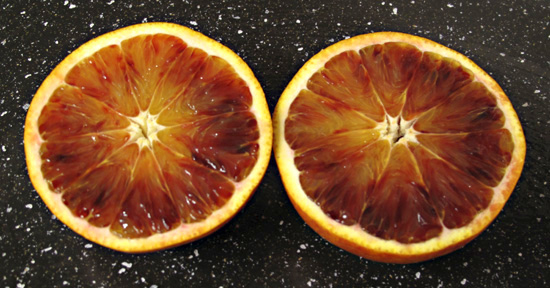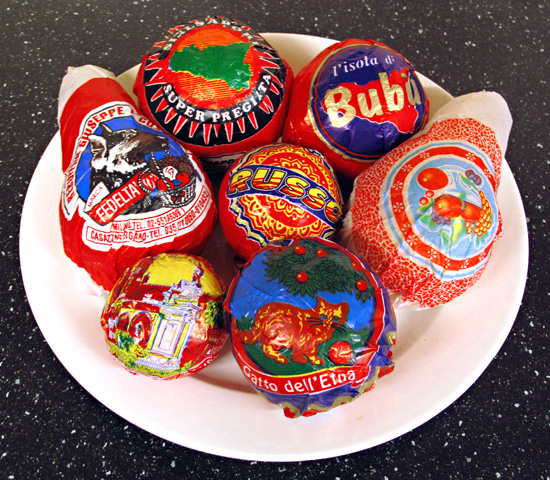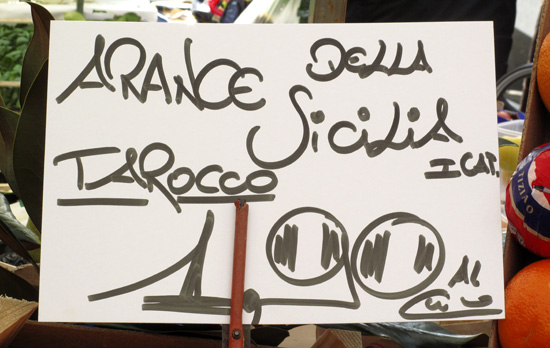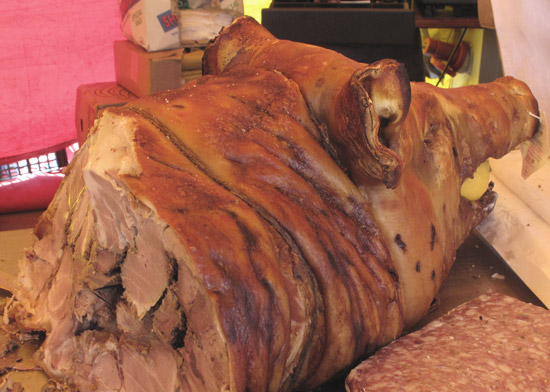
by Maureen | Apr 1, 2010 | Cheese, Discoveries, Featured Articles, Firenze, Food!, Incredible Locations, Journal, Photo of the Day, Photos, Shopping & Markets
After the flea market at Piazza dei Ciompi in Firenze last Sunday, I walked a few blocks further and saw yellow-tented stalls. Hmm. A food market: cheeses, meats, breads and a few other goodies. Some from Toscana (Tuscany), Firenze’s region. Some spicier ones from the south.
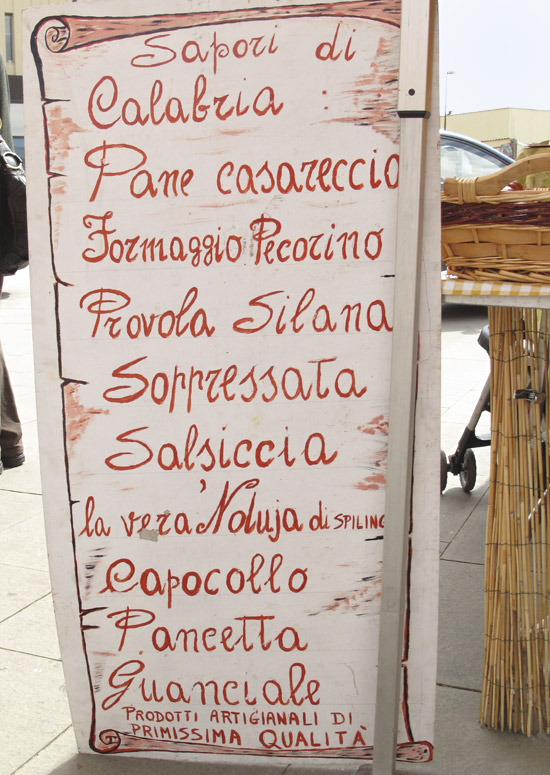
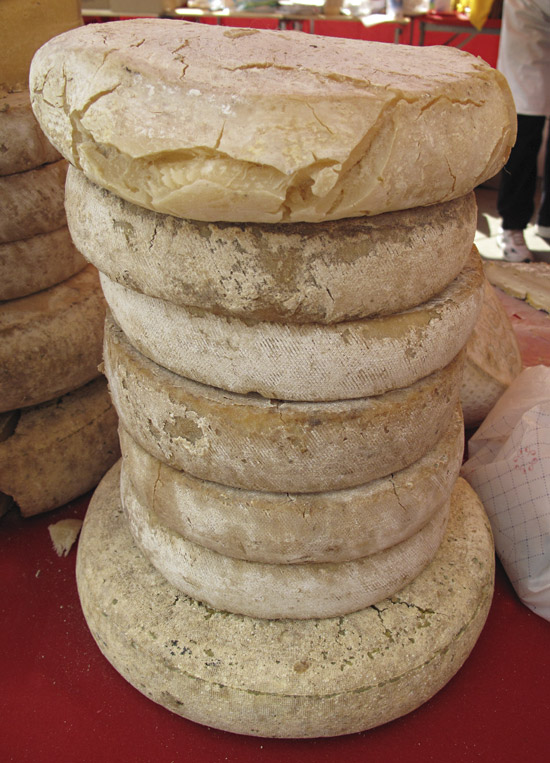
‘Nduja is a casing-stuffed meat that is spicy and spreadable. Very nice with good bread.
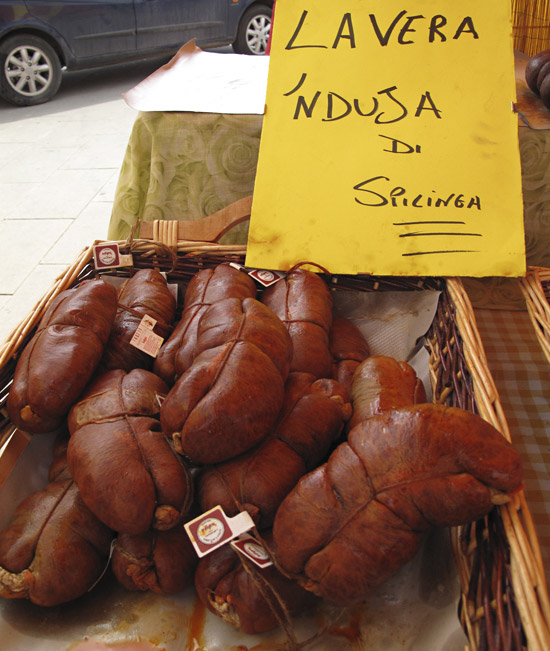
“Do you have a problem with cholesterol? Diet? The solution is Tometta (cheese) of 100% pure goats milk. Lower fat content.”
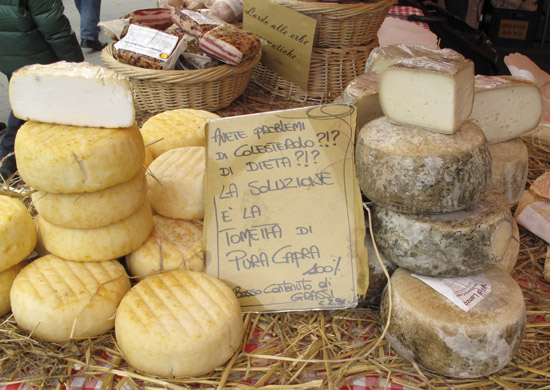
How about some deer meat salame?
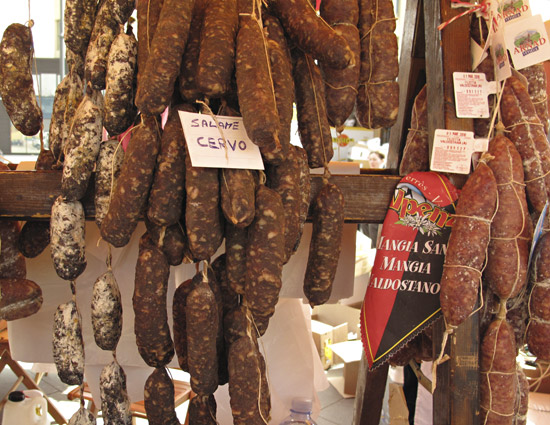
I sampled gorgonzola mixed with black truffle and bought a little tub of that to take home. Sampled from a big round of pecorino. Then walked up to a meat vendor that fed me enough samples that I didn’t need lunch. They offered huge, cased, cured meats from which they’d shave a piece and use the knife to hand it to me: prosciutto, porchetta, salame, soppressata. I tried them all, peppered and mild, whole, ground and chunked and knew I wanted to buy a piece. After all the samples, I was indecisive because I liked them all, but I bought soppressata.
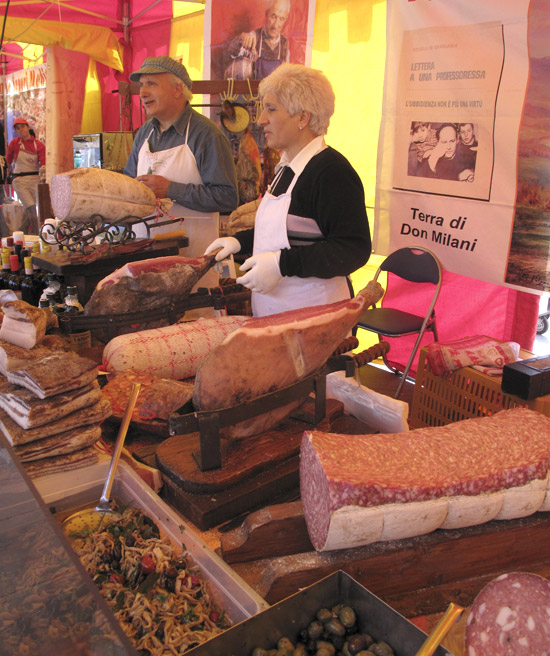
In the photo below, soppresatta is the large-chunk round near the black-rind cheese.
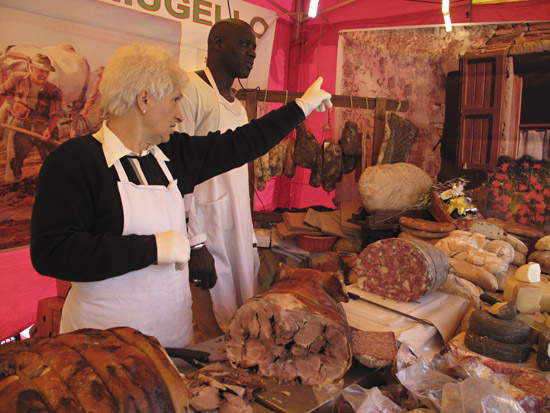
In nine months this is one meat I hadn’t tried yet because it’s a Tuscan meat and not so common up north. My markets don’t offer it. Soppressata is made of the left over parts of the pig: cartilage, tongue, head scraps… you name it, nothing’s wasted. The head is boiled for a few hours then picked of meat, skin and all “edible parts”. All of the picked bits are chopped large, seasoned, and stuffed into a casing about 10″ across. The broth from cooking is poured into the casing to cover the meat parts. It is then hung and the liquid thickens and binds everything into a solid. (In the U.S., it might be called “head cheese”.)
The soppresatta that this vendor offered had a nice peppery bite to it. Soppressata omelette? Soppressata burger? “They” are saying that soppressata pizza is the new big thing. I believe it.
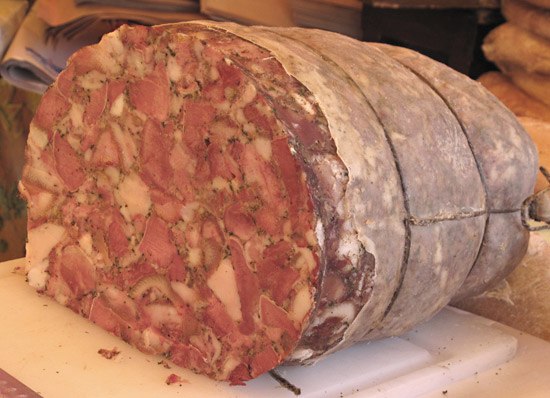
Here’s the front end of the porchetta – roast pig.

With gorgonzola and soppressata in my bag, I continued walking. I should have bought a nice Tuscan bread to bring home on the train, but didn’t. I’ve always marveled at these HUGE loaves I see at the markets. Ask for some bread and they just whack off a chunk. These loaves are about 4 feet long.
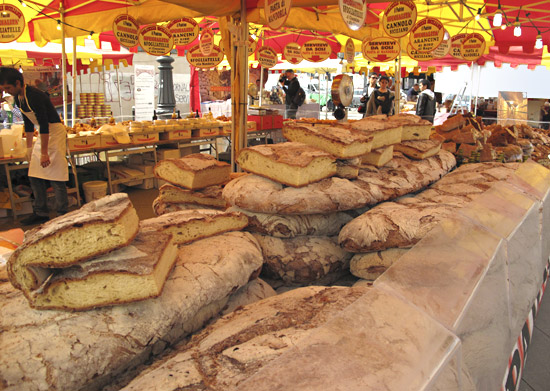
And look at this green olive bread!
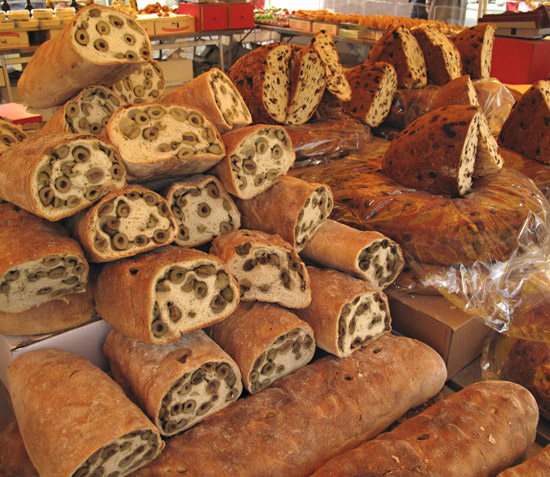
This Toma cheese is so beautiful to look at.
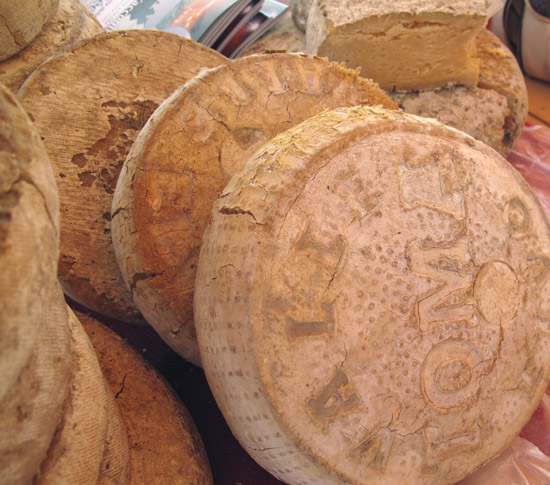
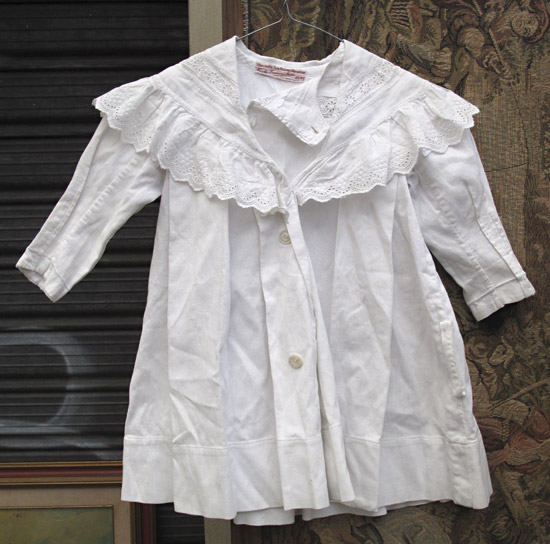
by Maureen | Mar 30, 2010 | Featured Articles, Firenze, Incredible Locations, Journal, Photos, Shopping & Markets
A month ago I was given a hot lead from a girlfriend in Seattle about flea markets in Firenze. What I uncovered through some digging was that the “hottest” market happens on the last Sunday of the month, in the Piazza dei Ciompi, just a few blocks’ walk east of the Piazza del Duomo. OK. That little fact determined the timing of my return visit to Firenze.
I even set the alarm Sunday morning(!), ate a quick breakfast and started walking the mile to the piazza. Along the way, I kept seeing people carrying branches and scratched my head over that. Hmm. Oh! It was Palm Sunday but they were carrying olive branches, not palms! I stepped into the Basilica della Santissima Annunziata mere moments before mass started and witnessed the procession of priests and parishioners.
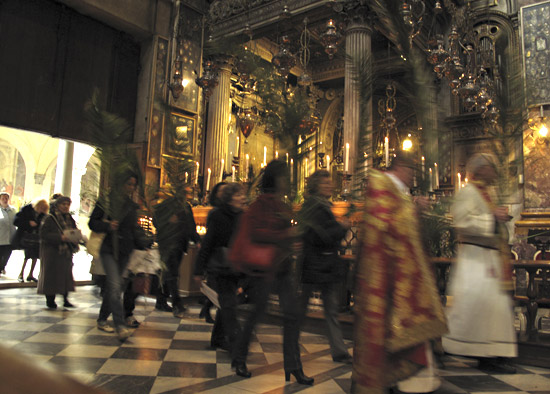
The portico between the church and the “cloister of the dead” offered a heaping bale of olive branches, so I plucked a few little twigs to carry in my pocket, then continued my mile walk.
When I arrived at the Piazza dei Ciompi, I found many of the things I expected AND I found most everything I was looking for. On the last Sunday of the month, the flea market spills out into the side streets, populated by many of the local antiques dealers surrounding the piazza. There are the vendors that know what they have and charge high prices accordingly. And there are those that have a mixed pile of junky tidbits with a “treasure” tucked in here and there. The concept must be universal among flea markets and swap meets.
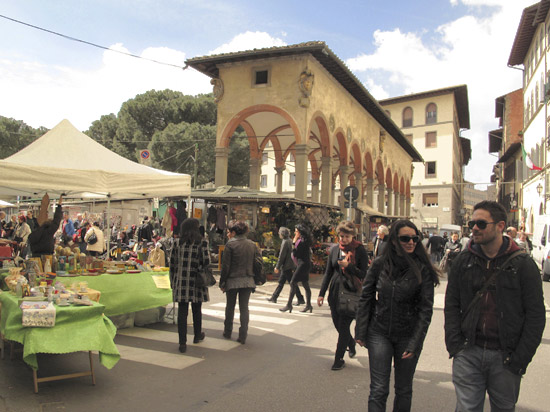
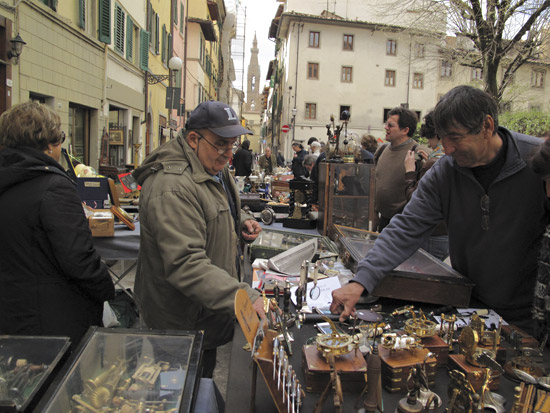
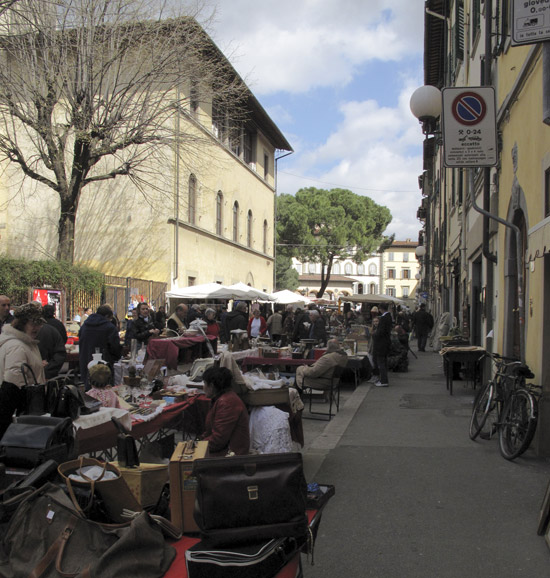
Of course there were iron pieces, linens, books, figurines, clothing, costume jewelry, housewares and miscellanea. What I went in search of were red-stitched linens (thinking of my great, great grandmother and Frette linens) and old penmanship guidebooks. I found both! What I didn’t find are the meat and milk signs like I’ve seen hanging outside markets around the country. I’d gladly hang them outside my door at home in Seattle!
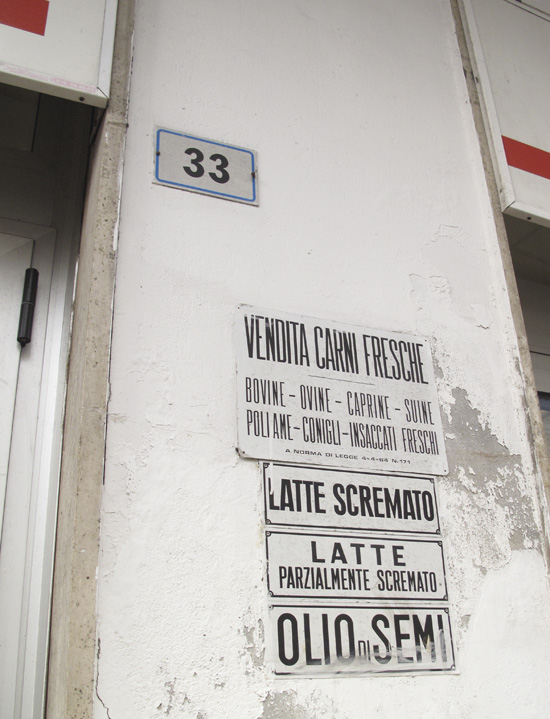
Look at these hat forms! The vendor had about a dozen of them. Many different hat shapes. Beautifully-sculpted hardwood! If I remember right, they were selling for about 80 euro each (about $107).
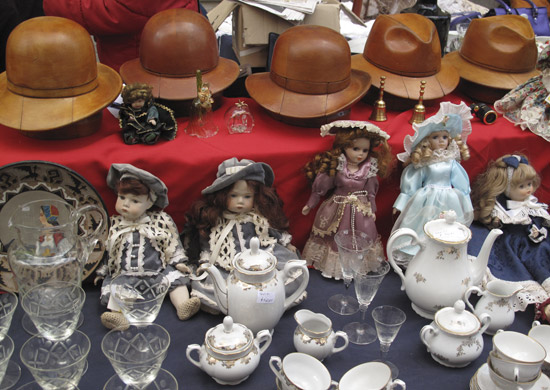
Years ago, both of my Grandmas let me paw through their button boxes and select my favorites. I now have a collection of thousands of buttons, especially mother-of-pearl. I dig into my collection when I’ve sewn something and need just-right buttons. When I saw these boxes full of buttons, I was hopeful, but in the end unwilling to pay 50 cents per pearl button.
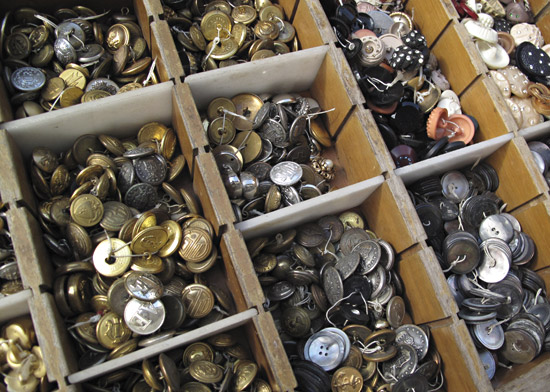
This lovely, white, cotton-with-eyelet dress from Roma was hanging toward the back of one seller’s stall. Darn. It wasn’t for sale. I would have brought it home to little 5-month-old Audrey, whom I haven’t even met yet (!)


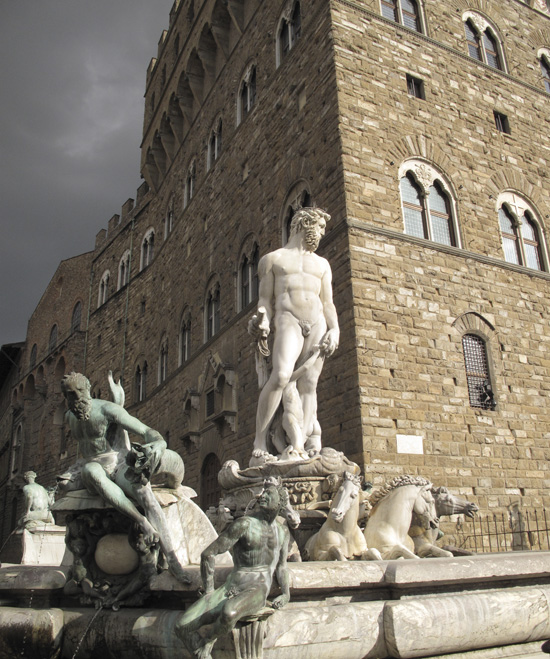
by Maureen | Mar 30, 2010 | Discoveries, Featured Articles, Firenze, Food!, Incredible Locations, Journal, Meals, Photos, Shopping & Markets
If you haven’t been to Firenze (Florence), put it on your “life list” of must-see places in the world. Really.
Two years ago I spent a couple of afternoons exploring Firenze, but I hadn’t been back since I returned to Italy last June. So I hopped on the train late last Friday morning, and less than two hours later, at 1:00, I arrived in Firenze and smiled. I walked from the train station to my hotel shooting photos along the way because I couldn’t wait until I put my bags down. I checked in, changed my clothes for the bit of humidity under the partly sunny skies, then left and took off walking for the next five hours.
If I were to move to Italy NOW, or want to relocate to another spot, I would pick Firenze.
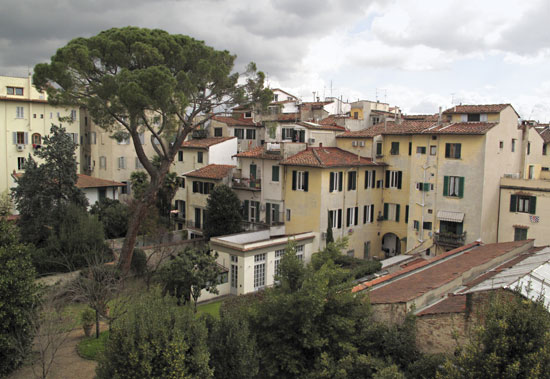
Excerpts from my journal Friday night, 26 March 2010 , while resting my feet and having a delicious dinner:
“I love Firenze! At this point, with what I know and with my familiarity and my language, I’d move to Firenze. Milan was a great place to land and gave me anchors. I find much to interest me there. My camera is always at my side and I can stay as busy as I wish, but in just an afternoon, Firenze has thrilled me with its visuals, much the way that Venezia does.
“It’s very definitely a tourist town! I think that Spring/Easter vacations have begun because the clustering tour groups are everywhere and unavoidable. (I thought that, late March, I’d still be missing them all.)
“Firenze – Florence – is ‘tighter’. Narrower streets close into the center of town around the Duomo, and many ‘pedestrian-only’. the selection of little shops, restaurants and curious places gives much to explore without going far. The antiquity is a saturated wash over the town and gives it a texture that is lush across-the-board. Like Venezia, I could photograph here forever.
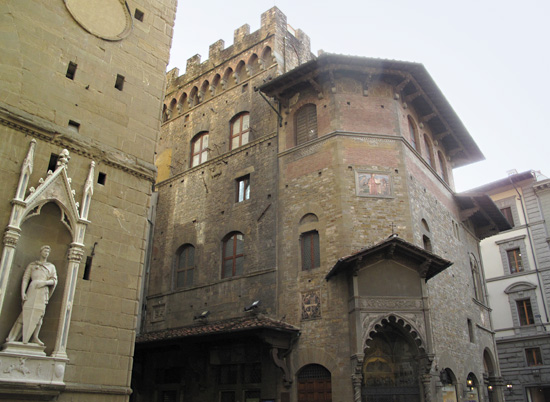
“I’m sitting at a table for two at Zá-Zá, a lovely, dar, funky, delicious trattoria just blocks from my Hotel Caravaggio. There’s been a table of four sitting near me having their meal, their drinks and their desserts. I smiled at them once… As they were leaving, the woman that had been nearest to me said goodbye – ‘Arrivederci‘. That tickles me.” (I highly recommend both the restaurant and the hotel.)
Excerpts from my journal Sunday afternoon, 28 March 2010 , on the train heading home to Milano:
“I had an incredible, full time in Firenze. So glad to have gone back, and with only an hour and 45-minute train ride, I could come for a day if I wanted to, or just an overnight.
“The city of Firenze, though packed with tourists, seems to have a quite comfortable parallel world of locals that go about their days and their work. With transportation and services so readily available, Firenze seems quite livable and pleasant.
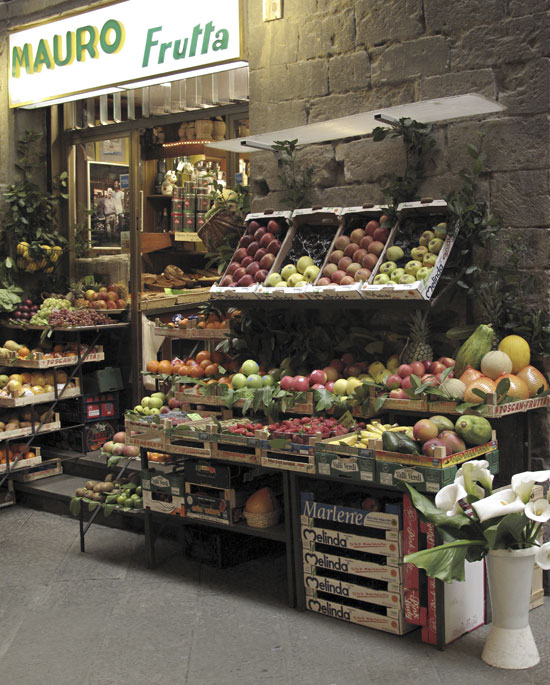
“I very quickly got the-lay-of-the-land and covered much of the “Centro Storico” – the historic center of town – in my two days there, walking close to 20 hours overall.”
Yesterday evening, a friend asked by e-mail, “Should Florence be on my to-do list? What did you especially like about it?” I responded with an off-the-cuff, spontaneous list:
Everyone’s on foot or bike! The whole historic center, large radius, is almost all pedestrian-only with very few cars and some half-size, mini-buses. Walk everywhere. (I don’t think there IS a subway, but lots of public transportation.) Streets are narrow and closer in for easy strolling. NO traffic to even have to think about.
Absolutely fascinating art, history, culture, architecture at EVERY turn!
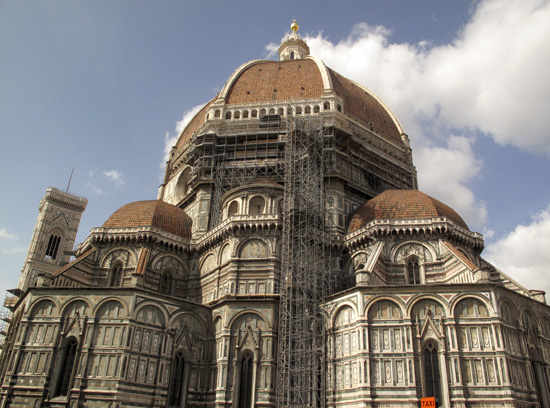

Historic sites. Historic art: Michelangelo’s David. Botticelli. Caravaggio. Dürer. Giotto. Leonardo. Lippi. Raphael. Rembrandt. Rubens. Titian. And so many more!
Visually lush. Vital, Small-city-energy.
VERY tourist-oriented (which I didn’t like having the vacation tours already swarming) but it felt like there was a parallel universe happening of people just going about their lives.
Florence doesn’t have the crazed-busy-frenzy of business-minded Milan.
Cool stuff for curious kids and adults alike. Sundials and crenulated towers.
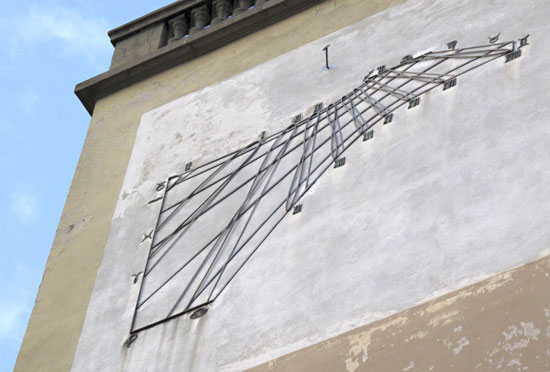
Good gelato.
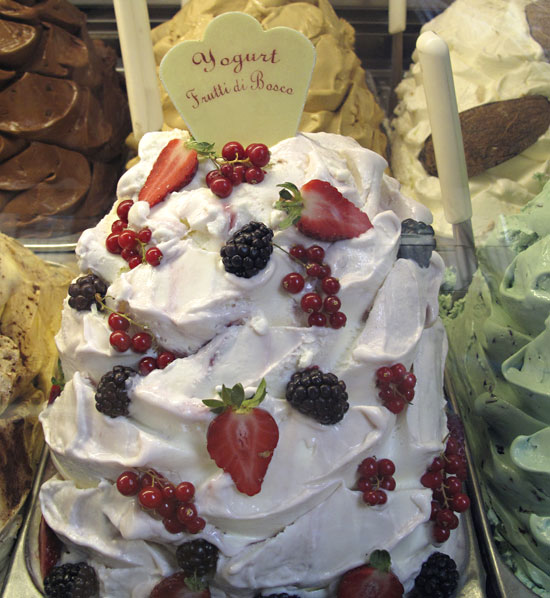
Neat bridges.
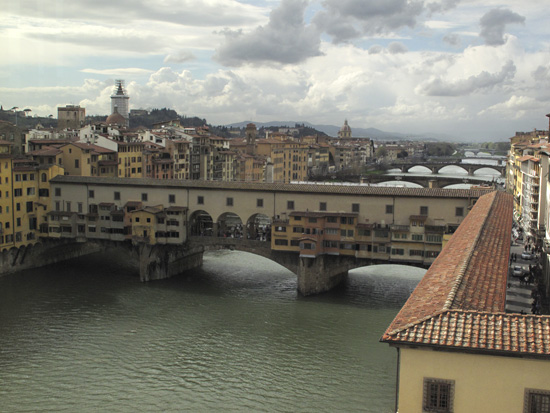
Street markets selling you-name-it.
Good cow-stomach sandwiches. (Lampredotto.)
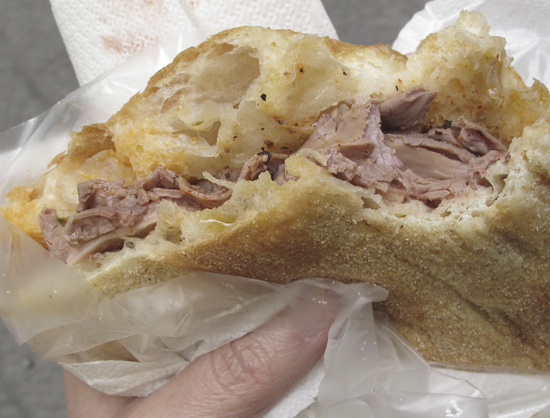
The heartland of the Renaissance.
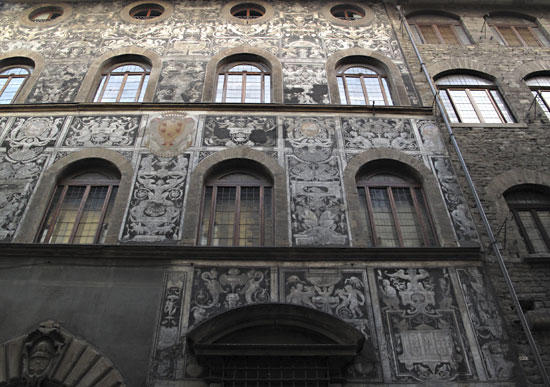
Oh. And they have curb-cuts designed for uninterrupted walking.
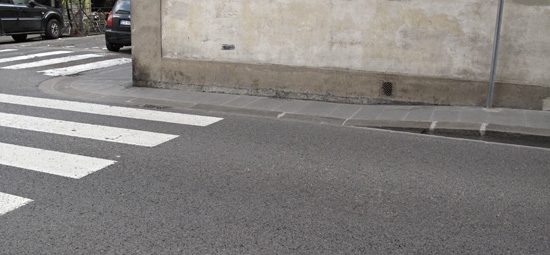
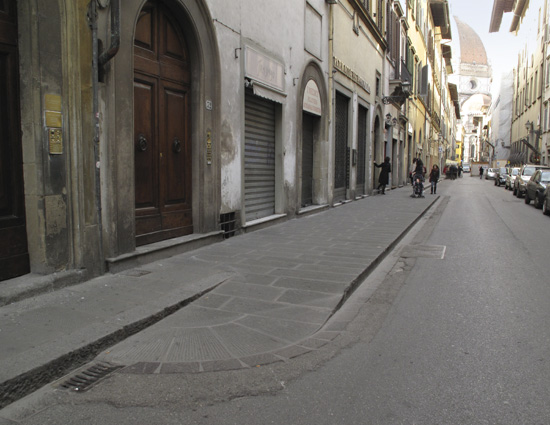
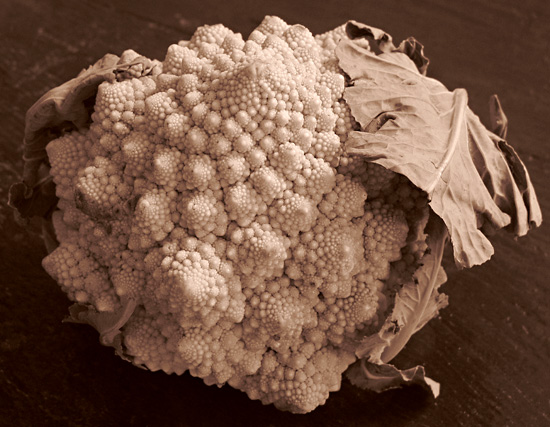
by Maureen | Mar 24, 2010 | Discoveries, Featured Articles, Food!, Journal, Photo of the Day, Photos
They call it “Cavolfiore” or Cauliflower here, but Americans call it “Romanesco Broccoli”. Either way, it tastes great, it’s absolutely beautiful, and it’s math on your plate.

The Romanesco is a clear example of fractals and the fibonacci number sequence.
See how the whole head of Romanesco is made of smaller heads that mimic the shape of the bigger head, and each of those smaller heads is made of even smaller, duplicate heads? Fractals!
FRACTALS: “A fractal is a rough or fragmented geometric shape that can be split into parts, each of which is (at least approximately) a reduced-size copy of the whole… Because they appear similar at all levels of magnification, fractals are often considered to be infinitely complex (in informal terms).” (Check Wikipedia for cool examples and further explanation: http://en.wikipedia.org/wiki/Fractal)
And you see the ever-expanding spiral emanating from the center point along which all the smaller heads are arranged? The Fibonacci sequence and the Fibonacci spiral!
FIBONACCI: “In the Fibonacci sequence of numbers, each number is the sum of the previous two numbers, starting with 0 and 1. Thus the sequence begins 0, 1, 1, 2, 3, 5, 8, 13, 21, 34, 55, 89, 144, 233, 377, 610 etc.” (Wikipedia, http://en.wikipedia.org/wiki/Fibonacci)
Click HERE for a beautiful video by Cristóbal Vila about numbers as they establish patterns in nature.
*TWO words are Italian!
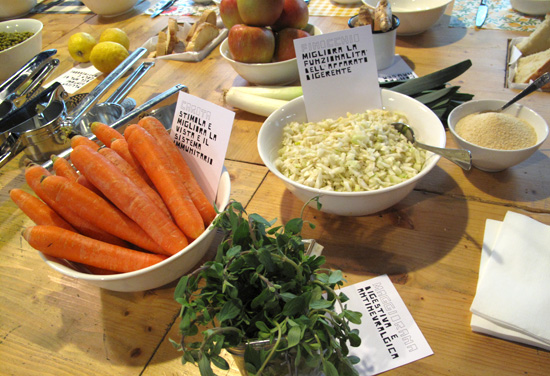
by Maureen | Mar 21, 2010 | Cheese, Discoveries, Featured Articles, Food!, Introspection, Journal, Meals, People, Photo of the Day, Photos
Would you let 30 random strangers eat off your plate? Would you, in turn, eat off the plates of those 30 strangers?
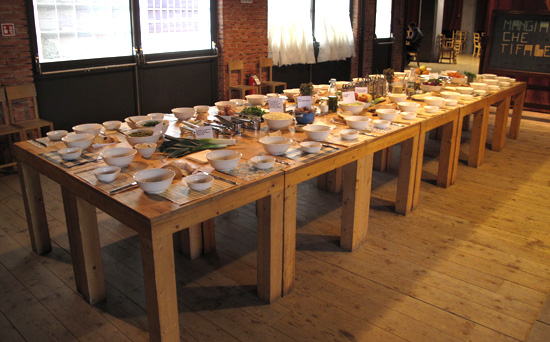
The Uovo Performing Arts Festival included one “performance” yesterday of 30 individuals, by reservation only. “Mangia che ti fa bene”, “Eat that you will feel well.” For 10 euro, or about $13.50, I walked into the room to a very long table with 30 place settings, and a variety of ingredients:
- bread
- water
- eggs
- grana cheese
- cabbage
- parsley
- apples
- beets
- sesame seeds
- pumpkin seeds
- fennel
- olive oil
- garlic
- spices
- cooked peas
- oats
- radicchio
- spinach
- fresh ginger
- lemon
- leeks
- carrots
- walnuts
- fresh herbs

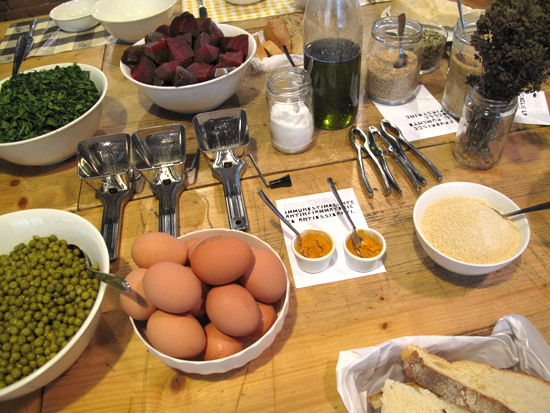
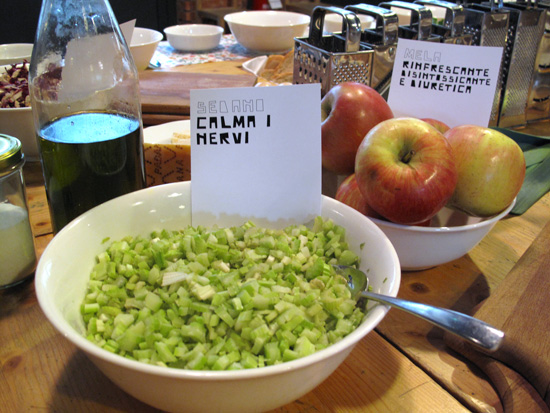
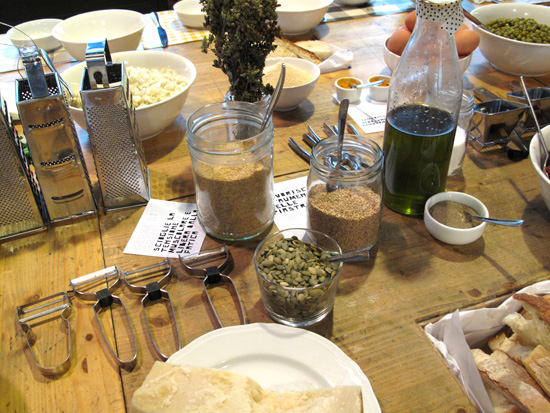
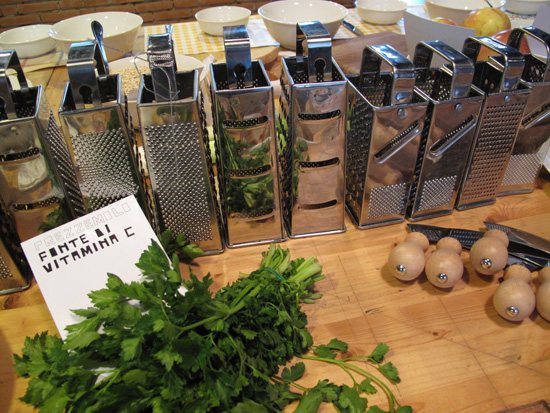
We were given limited, very loose guidelines.
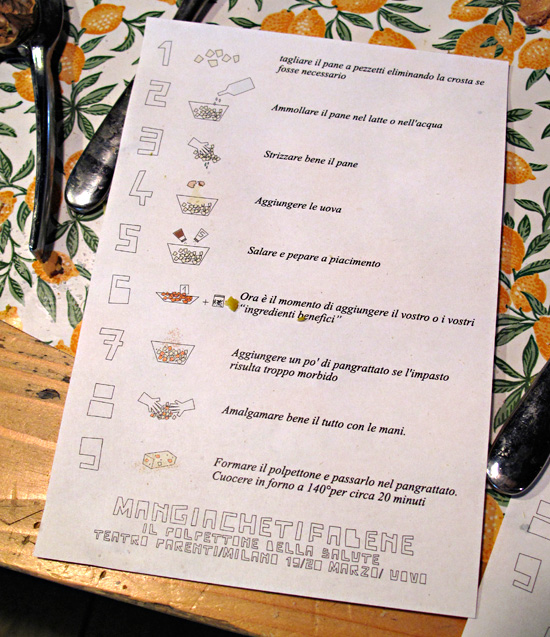
We each grabbed a plastic apron from the group taped to the window.
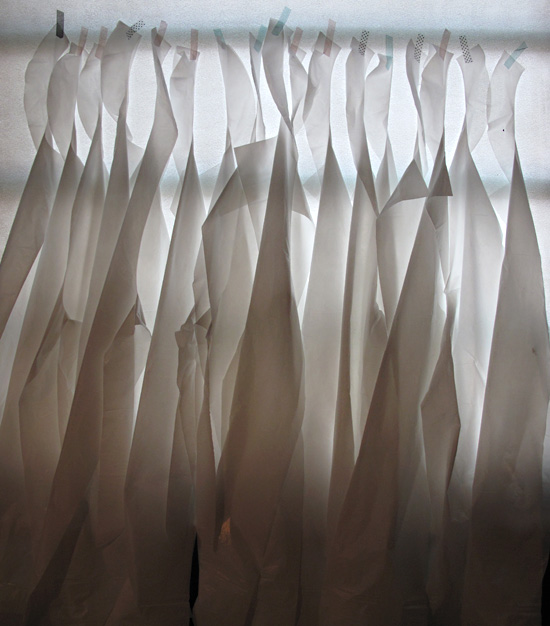
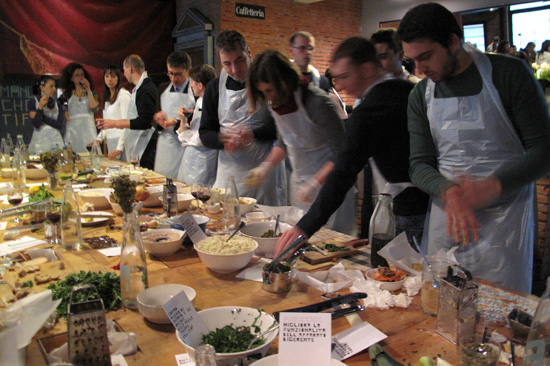
Our project was to gather whatever combination of ingredients we desired, blend them and put the mix into a paper-lined, 3″ x 5″ foil pan. The 30 of us were elbow-to-elbow at the table and we were being filmed. We had graters, sieves, knives, bowls, half-moons and cutting boards at our disposal. Notes were provided about the health-inducing properties of each food item.
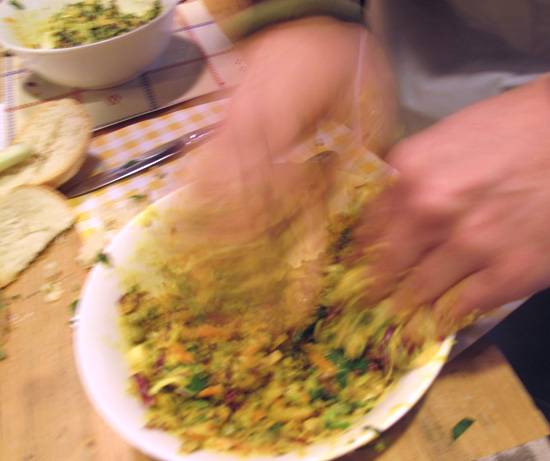
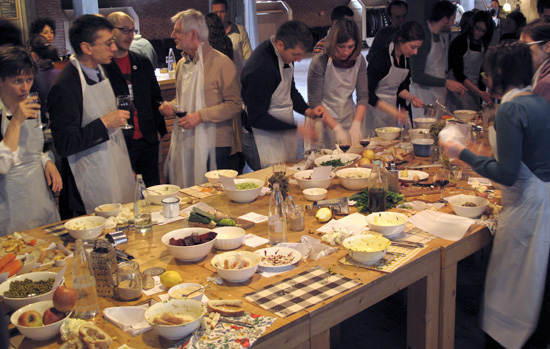
We asked for ingredients to be passed. We reached across the table. We laughed and chatted and mixed with our hands until our concoctions looked just right to us. Some pressed the ingredients through sieves for a uniform consistency. Others left chunks for spikes of flavor. Some formed loaf-like logs, while others patted their mix into flat casseroles. We bound up our creations in oven paper, scrawled our names on the wrap and sent the little tins off to be baked for 30-45 minutes.
While our dinners were baking, we were served lemon-slice salad, celery sticks with honey, and braised celeriac root. For our 10 euro, we also got a glass of red wine and some herb tea.
Trays of foil tins emerged from the oven, and the hostess called out names. One-by-one, the “performers”, the dinner guests, opened and tasted their creations. There were 30 recipes at the table. Like a groundswell, the sampling started. People reached over with their forks and sampled their neighbors’ meals, and everyone started passing their dish around for others to taste. It was remarkable the range of culinary directions we had each taken. I realized later that I could have gone in the sweet direction and combined bread, egg, apple, ginger, lemon and arrived at a dessert to contrast with all the savory gratins at the table.
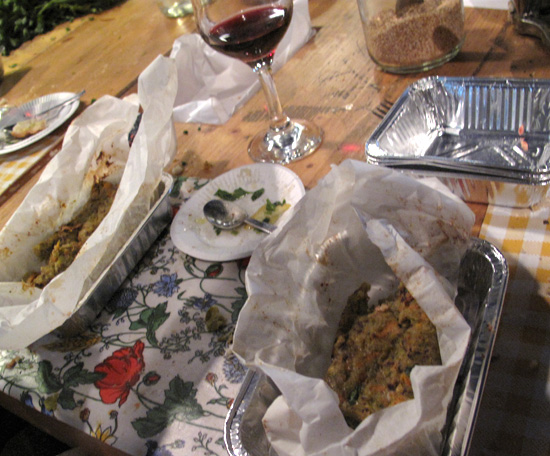
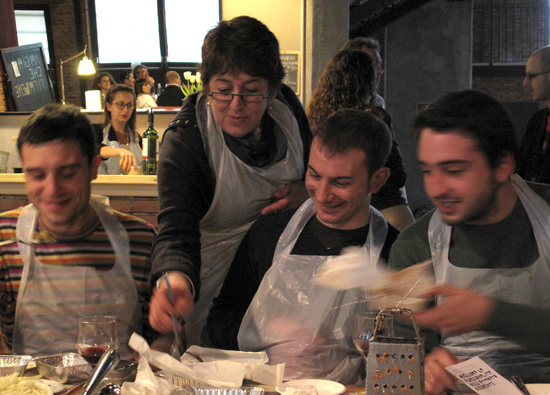
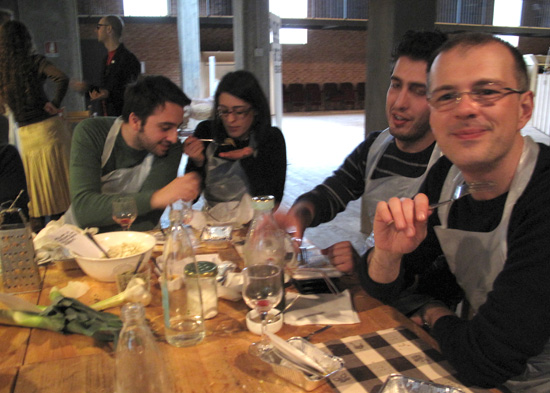
I looked around, tickled, chuckling and amazed. Would this happen in the U.S.? Could it? How could I bring this experience to Seattle? To Burien? I easily tallied that the 30 people at 10 euros each only brought in 300 euros. And I looked at all the food, and the utensils, and the wine and thought that surely this was not a money-making proposition. In the U.S., liability insurance alone for a one-day event of this nature would probably be prohibitive.
And would people in the U.S. be willing to pass their dish for their unknown neighbor to sample from, and then fork a bite from their neighbor’s plate and relish the combination of ingredients different from their own?
This does give me ideas for an uncommon Thanksgiving dinner… but many in my family would likely balk at the idea. (But they wouldn’t be random strangers.)
– – – –
Here’s the official, “as advertised” description of the event:
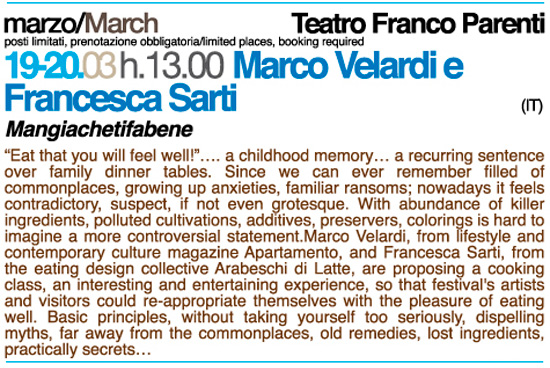
The aftermath was a mess of a table!
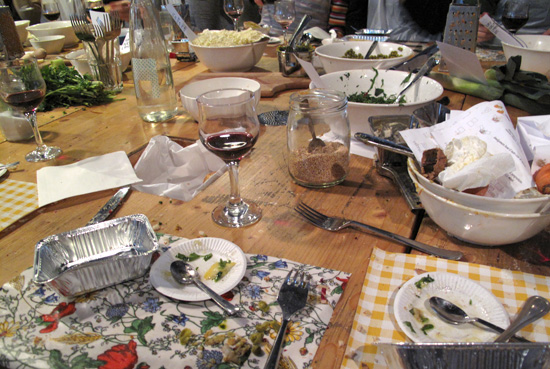
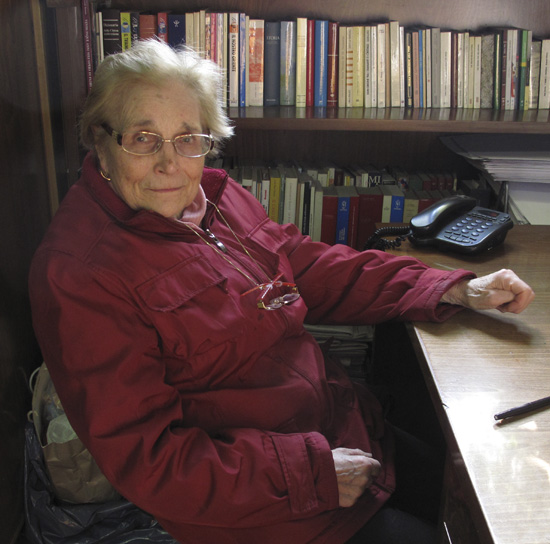
by Maureen | Mar 18, 2010 | Discoveries, Featured Articles, Journal, People, Photos
Last June, just a few days after I had arrived here in Milano, I went to the Cimitero Monumentale – the Monumental Cemetery – to look around. It is, indeed, “monumental” and every bit worth an afternoon of strolling and looking. As they say, it is WAY over the top! One can study architecture, sculpture, typography and history. The structural monuments are bigger than my apartment and of every possible architectural style. Every family grave plot features a noteworthy sculpture. That cemetery provides a very concentrated study location, like none other I know.
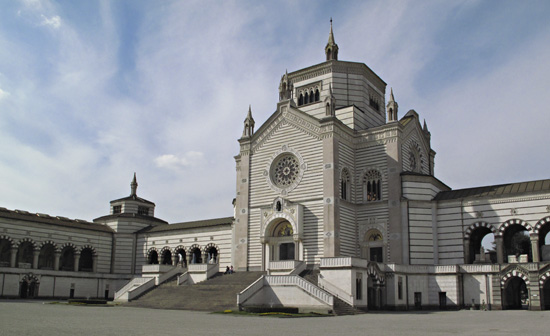
So, back to Mary. In June, after being awestruck by the cemetery grounds themselves and feeling saturated by it all, I started toward the exit, through the main “gallery” building. I heard chanting and the monotone of prayer, and it changed my course. Around back and in the lower level is a small chapel. I approached the doorway and simply stood outside, listening to the rhythm of women saying the rosary. At the doorway was a simple stand with a listing of the names of the recently deceased, for whom the women were praying.
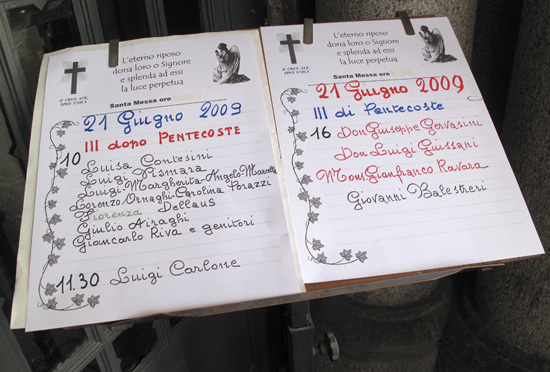
The handwriting stopped me! SO unlike what we learned long ago in school in the U.S. So European. So distinctive!
Lately, as I have continued to intensively “mine” Milano for design references, that very particular handwriting has pulled at me. I went back to the cemetery on Monday, to shoot the day’s page of names, however, the cemetery was closed. I went back again today and made a bee-line for the chapel front. Yes! There it was. That lovely, lyrical, not-quite-cursive pen! I photographed each of the 3 sheets posted there, then turned north for a tour of the cemetery.
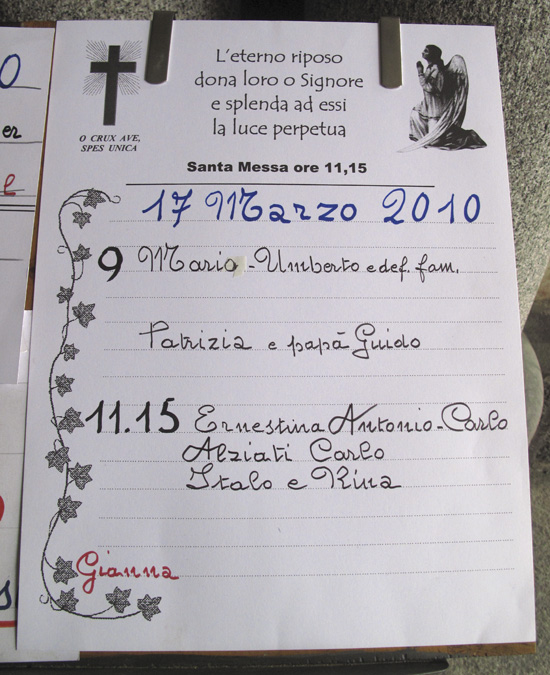
Mary’s capital letter “M”:
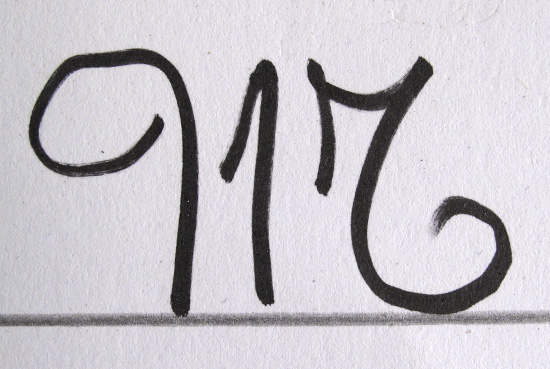
During my slow amble, one of the cemetery workers approached me and asked if I wanted to see the Campari tomb. (This cemetery holds the remains of all the “big-name families” of Milano: Campari – the drink, Ferrari, Pirelli, Zucchi and many others. The sources of all the street names in town!) Of course I said yes, and he, Salvatore, took me to the northwest area of the grounds and to the grand tomb capped by a sculptural “Last Supper”. At it’s backside was an open vault with a beautiful mosaic covering walls and ceiling.
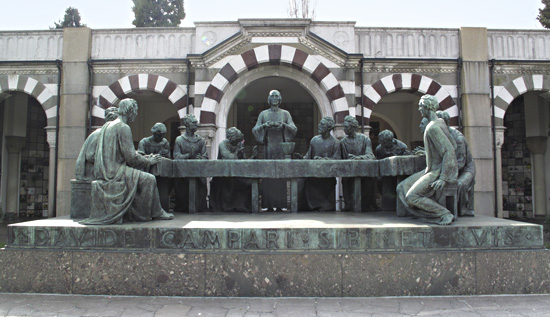
While Salvatore and I chatted, I showed him the pictures I had shot of the wonderful handwriting. I asked if he knew who had done it and said that I would like to meet her. (It speaks of femininity, so I assumed it was a woman.) I didn’t understand everything he said, but it was something about 3 o’clock and come back another time. (It was then about 1:30.) I thanked him for his help, said goodbye and kept looking around.
Time flies in that incredible cemetery. It would be hard to tire of that place, impossible to cease seeing something new. I saw Salvatore again and it was after 3:00. He suggested that I might be able to meet the person that wrote the pages, so he took me to the brown-cloaked priest and I explained who I was looking for. Father signaled for me to follow him, and we wrapped through the crypt-filled hallways to a nondescript door which led into the back of the chapel. He took me through a few interior halls to a room with a western window and the afternoon light… and Mary.

I told her how beautiful her handwriting is and that I couldn’t stop thinking about it lately. It’s the most beautiful and distinctive I’ve seen here. Using all the “polite” Italian I could remember, I asked her if she would kindly write out an alphabet and number set for me, with upper and lower case letters. She seemed tickled and agreed, but asked if I would come back another day to pick it up. She wanted time to do it well.
Part of today’s list of names speaks of Don Giuseppe Gervasini, a priest that lived from 1867 to 1941 and is believed to have special healing powers. Mary – pronounced more like “Mah-ree” with a light trill to the “r” – carefully shuffled some papers in a deep drawer in her office and removed a wallet-sized photo of Father Gervasini. She gave it to me and instructed me to keep it with me always, saying that Don Gervasini would keep me protected. (A mass is being held in the chapel this Saturday at 10:00 in honor of Don Giuseppe Gervasini’s “name day” – onomastico. I guess I know what I’m doing Saturday morning.)
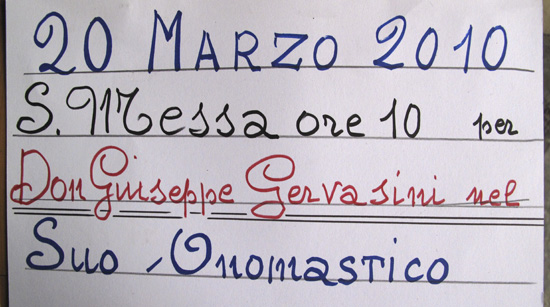
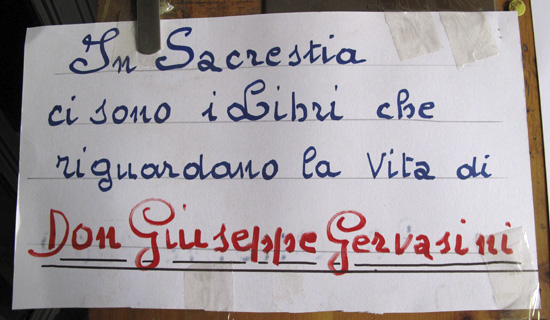
“Mary, Salvatore told me that you’re 84 years old.” “Yes. How old are YOU?” When I answered, she said, “I thought you were 30! You look like it!” I told her she’s sweet for saying so. She gave me a kiss on each cheek goodbye and I told her I’d be back tomorrow to come pick up the alphabet. (I’ll take her some flowers and some greeting cards that I made, as a little “thank you”.)
I absolutely beamed all afternoon as I left the cemetery! To have not only seen more of the handwriting I enjoyed so much, but to MEET the woman that does it, AND to have her agree to write out a full alphabet for me, AND to have her be so sweet to chat with… And I have such fondness for elder women. It is exactly these unexpected, unplanned, never-to-be-imagined meetings that charm my time here in Milano.
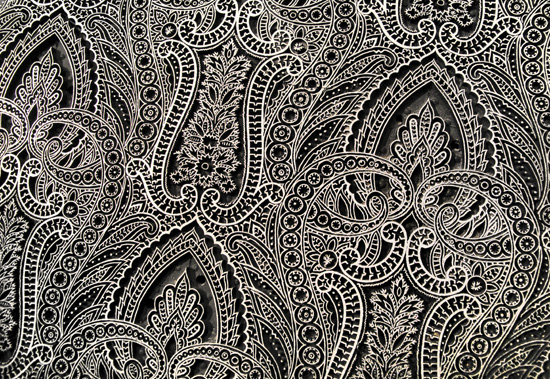
by Maureen | Mar 17, 2010 | Discoveries, Featured Articles, Graphics, Journal, Photo of the Day, Photos
When here in Milano in the summer of 2008, I stumbled upon a Zucchi Store just a half block north of the Duomo. They sell lovely household linens (sheets and towels) and they had a curious display in the window. I didn’t understand what I was seeing, so I had to go in.
Emerging up through a very large, circular hole in the first floor was a towering stack of flat wooden blocks. What were the blocks? It was then that I found out about the Zucchi Collection of wood-and-pewter blocks for printing fabric.
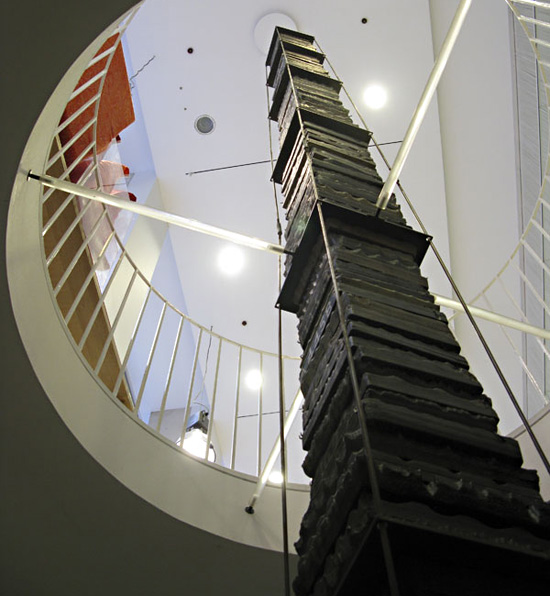
From the Zucchi Website: “The Collection’s 12,000 designs bear witness, over a period which spans three centuries from 1785 to 1935, to a fashion that was both varied and popular. Such tastes were apparent during one of the most energetic and fertile periods of European culture, which ended with the first stylistic experiments of the Art Nouveau and Art Deco movements.
“The Collection houses 56,000 printing blocks, an extraordinary number by any reckoning and one which presents concrete problems not only of space but also of storage in structures able to support the weight of many tonnes. The Collection is housed in three different storage locations: the Zucchi office in Casorezzo, the Via Foscolo location in Milan and a warehouse in Ossona.
“To make the Collection accessible not only to scholars but also to the fashion people, it was necessary to choose criteria by which the artefacts could be subdivided. The Zucchi Collection has been divided into six categories, which are identified in terms of iconographic forms: abstract, cashmere, floral, geometric, ornamental and pictorial. The Collection has been further subdivided according to the specific uses not only for the borders of the materials but also for foulards, bandanas, various ties, scarves and cravats, etc. A special data card, in computerised and paper formats, has been assigned to every series of blocks. Each of these contains various items of information about the handblock concerned, including the number of pieces which make up the structure, the design style it is capable of reproducing, its historical period and its origins. Attention has also been given to the question of conserving these structures and rightly so because the wood is sensitive material. The humidity and temperature levels require strict control and beeswax and turpentine must be applied to maintain the elasticity of the wood.”
A mere fraction of the collection has been on display on the lower floor of the Zucchi Store, including floor-to-ceiling, wall-to-wall shelves holding the numbered wood blocks. (They are now in the process of moving these blocks to another location.) Note that some designs have 3-5 different blocks to create the full design. (They are all numbered alike.) Being a lover of textiles I was immediately enamored of the collection.
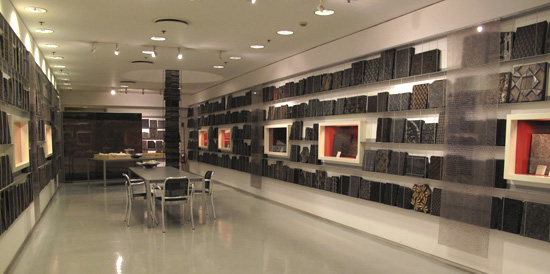
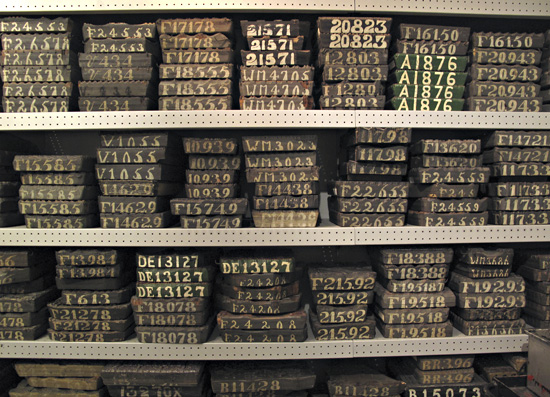
Fast-forward almost 2 years and now I’m living in Milano. Last Fall I found a curious and creative textile studio not far away named “L’Hub” on the Naviglio Grande, the “big” canal. One, they were selling vintage Zucchi linen and cotton dishtowels from the mid- and late-1900s. (Yes. I bought a bunch.) Two, they offer all sorts of creative textile classes including dyeing, sewing, construction, AND printing fabric with the centuries-old Zucchi blocks! Can you say “Sign me up!”?
I enrolled in the 3-hour class held last Saturday afternoon, taught by artist Franco Duranti (at the very far left in the next photo). Among other things, Franco is a painter, engraver, and video artist AND since 2007, he’s been creating original works with the Zucchi wood blocks! Below is a photo of the working studio at L’Hub. Some women were taking a sewing class, while two other women were also taking the fabric stamping class.
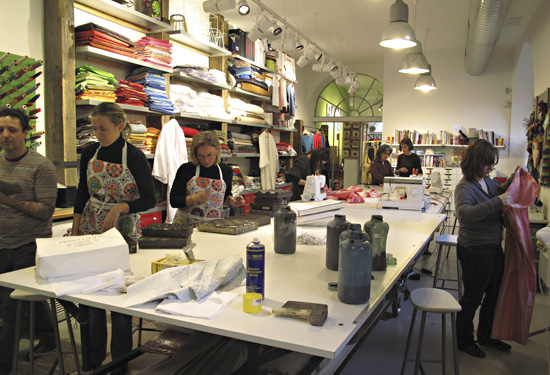
I wanted “classic”. I had just seen the Frette Textile Exhibit a week ago. I’m enthralled by the traditional fabric handwork of generations past and am especially inspired by my Great Great Grandmother’s work, done at age 12 in 1861. She crafted a cross-stitch sampler in “Turkey Red” on cream-colored cloth, and that color combination has launched me ever since my Grandmother gave me the sampler in 1975.
On the neighboring streets (on that recent day when I was getting snowflakes in my eyes) I scouted fabric stores and came away with Italian, 100% Linen. I bought a meter of fabric and took it home to prewash.
In familiarizing myself with the printing process, I chose a simple fleur-de-lis pattern printed in “carminio” – carmine red – on the linen. Note how, in this case, the block carries an “island” of cast pewter attached to the wood,
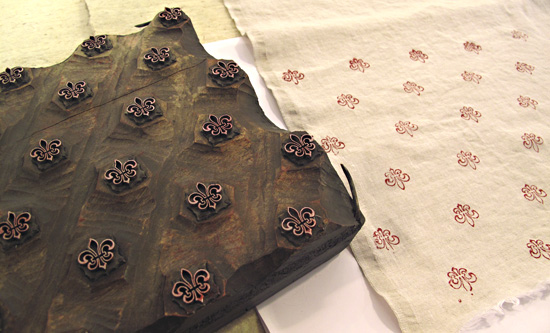
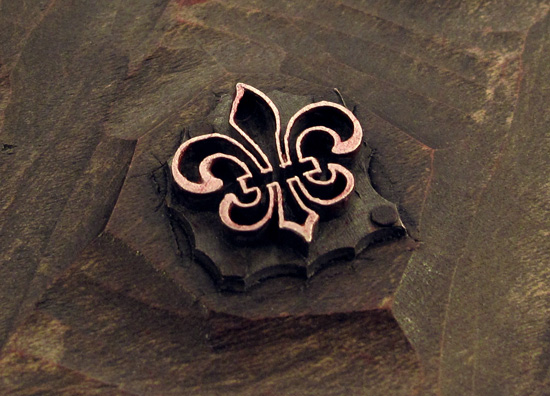
The following is an intricate, cast-pewter, paisley design from the “Cashmere” group of blocks in the collection. THIS makes my heart melt! Unfortunately, I was not able to print with this block, but printed with one I found that was as close as possible.

In gathering fabric for printing, I had also gone BACK to the Zucchi store downtown and they just happened to be having a sale! I bought two sets of sheets. One set is 100% cotton, satin finish with a subtle, printed khaki/cream pattern. I printed right over the top of the pattern to create a set of sheets like no other in the world.
I also paid a visit to the second-hand store 2 blocks away. I found white, cotton button-end pillowcases and bought all six at 2 euro each (about $2.75) When I got them home to wash them, I looked inside and noticed a… Zucchi label! Of course.
My plan now is to return to the L’Hub studio for a solo 3-hour stint to embellish the pieces I began, and to print even more.
As I wallow in Art and Design during my time here in Italy, I can’t imagine a more exhilarating addition to my list of design experiences than printing with the Zucchi handblocks at L’Hub!
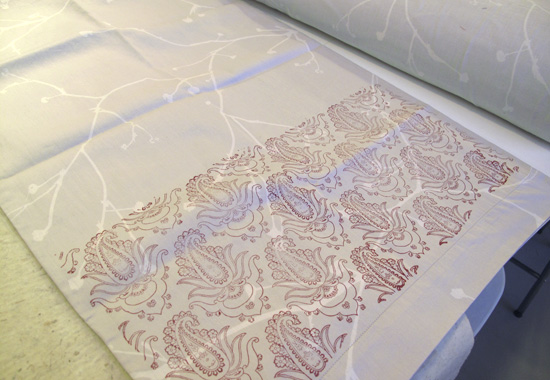
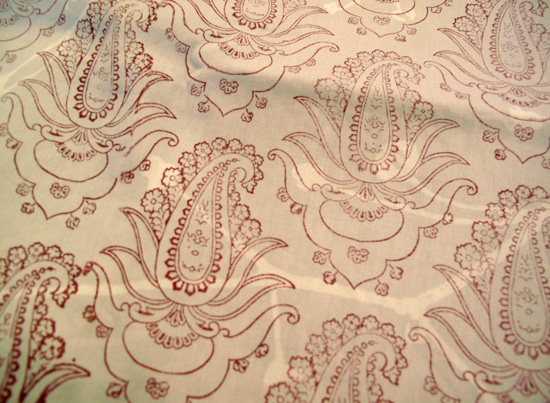
by Maureen | Mar 16, 2010 | Discoveries, Food!, Journal, Meals, Shopping & Markets
The other day I noticed the section in the meat department at the grocery store where they sell the “ends” of the prosciutto, mortadella, salami and other meats. I bought a prosciutto end for just a couple of euro; it was about the size of my fist.
Much of the meat was pretty dry, so without being sliced paper thin as is typical, it wasn’t optimal for eating. So: Prosciutto Soup! Besides. It was Sunday night and I hadn’t gotten to the grocery store in time so the pickins in my cupboard were slim.
I sauteed an onion and some garlic in olive oil. Cubed the prosciutto and threw it in the pan. I opened a can of fagioli borlotti, a bean that is white and speckled with deep magenta when freshly-shelled. I added a spoonful of vegetable bullion, but probably wouldn’t have needed to; it was WAY too salty, especially with the salt of the prosciutto. So I just kept adding water to the pot until the salt leveled out.
Everything simmered for about 3 hours and melded nicely while I sat here at the computer. The meat softened up. The beans thickened the broth a bit.
I’m probably breaking a lot of “rules” here, putting foods together in combinations quite atypical. But I came here without the food foreknowledge and preconceptions, so I simply see everything as an ingredient free-for-all. (That’s just how I cook, wherever I am.) Would a traditional cook make a soup such as this? I don’t know. If you know, please tell me!

by Maureen | Mar 15, 2010 | Discoveries, Featured Articles, Journal, Photo of the Day, Photos
JUST as they were on a crane removing this billboard ad for high-fashion lingerie, I was walking by with my camera and had mere moments to shoot. What will they put up next to keep the construction workers inspired?
This is a large, new complex being built at the north edge of town, right around the Garibaldi metro stop.

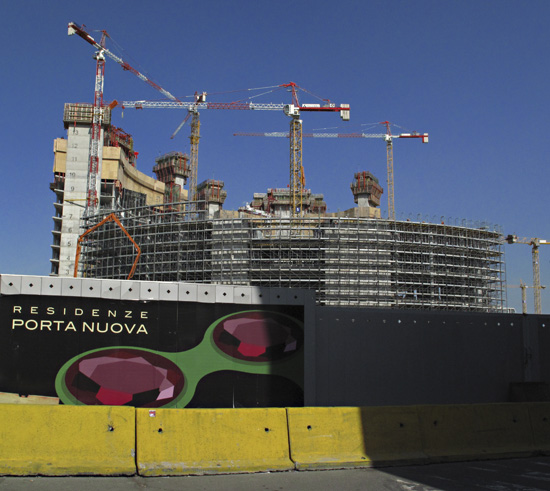
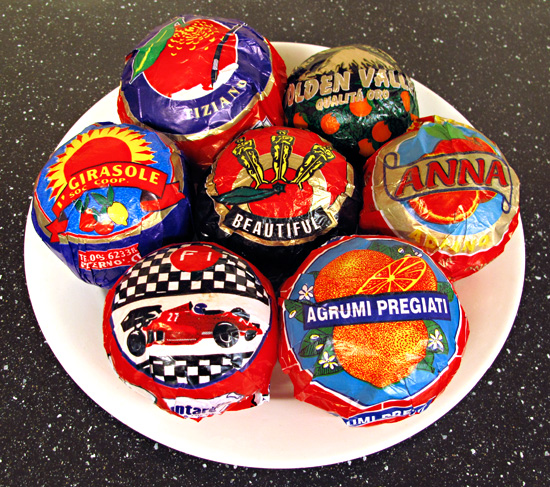
by Maureen | Mar 14, 2010 | Featured Articles, Food!, Graphics, Journal, Photo of the Day, Photos, Shopping & Markets
Yesterday morning I went to the local Saturday market on a mission: gather as many different citrus tissue wrappers as I could find. From each stall that had some of the paper-wrapped fruit, I bought two oranges, and mandarins if they were also wrapped. After cruising the whole market, I ended up toting home a lifetime’s supply of oranges, two heavy bags of citrus, plus a few wrapped pears.
At this time of year, most of the oranges seem to be the “Arance Tarocco“, the blood orange. Some I’ve purchased have been a very deep purple in color, fading to a classic, clear orange hue. Gorgeous, tasty, sweet.
The papers are such a study in design and imagery. I think my favorite is the Formula 1 Ferrari race car with the quintessential black and white checkerboard pattern. (What does any of that have to do with oranges?)

